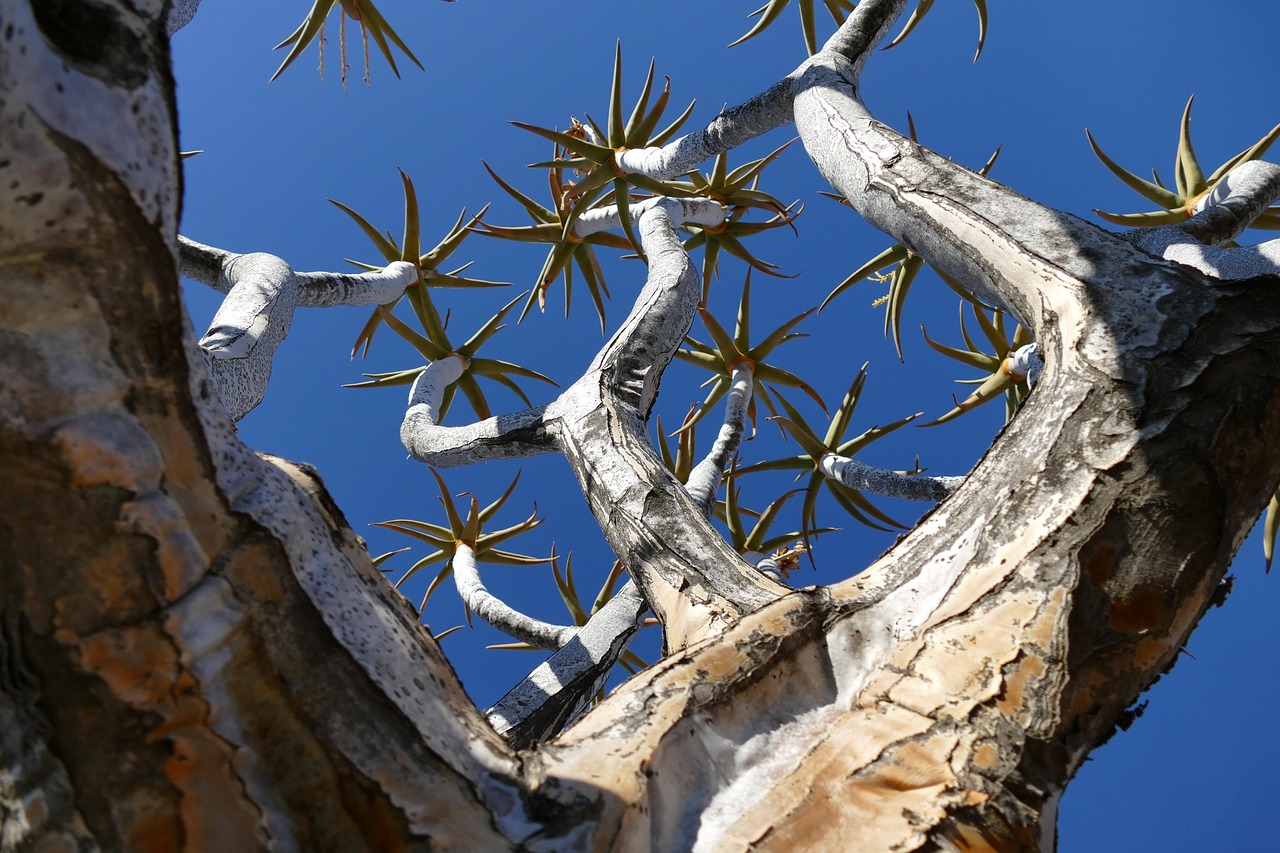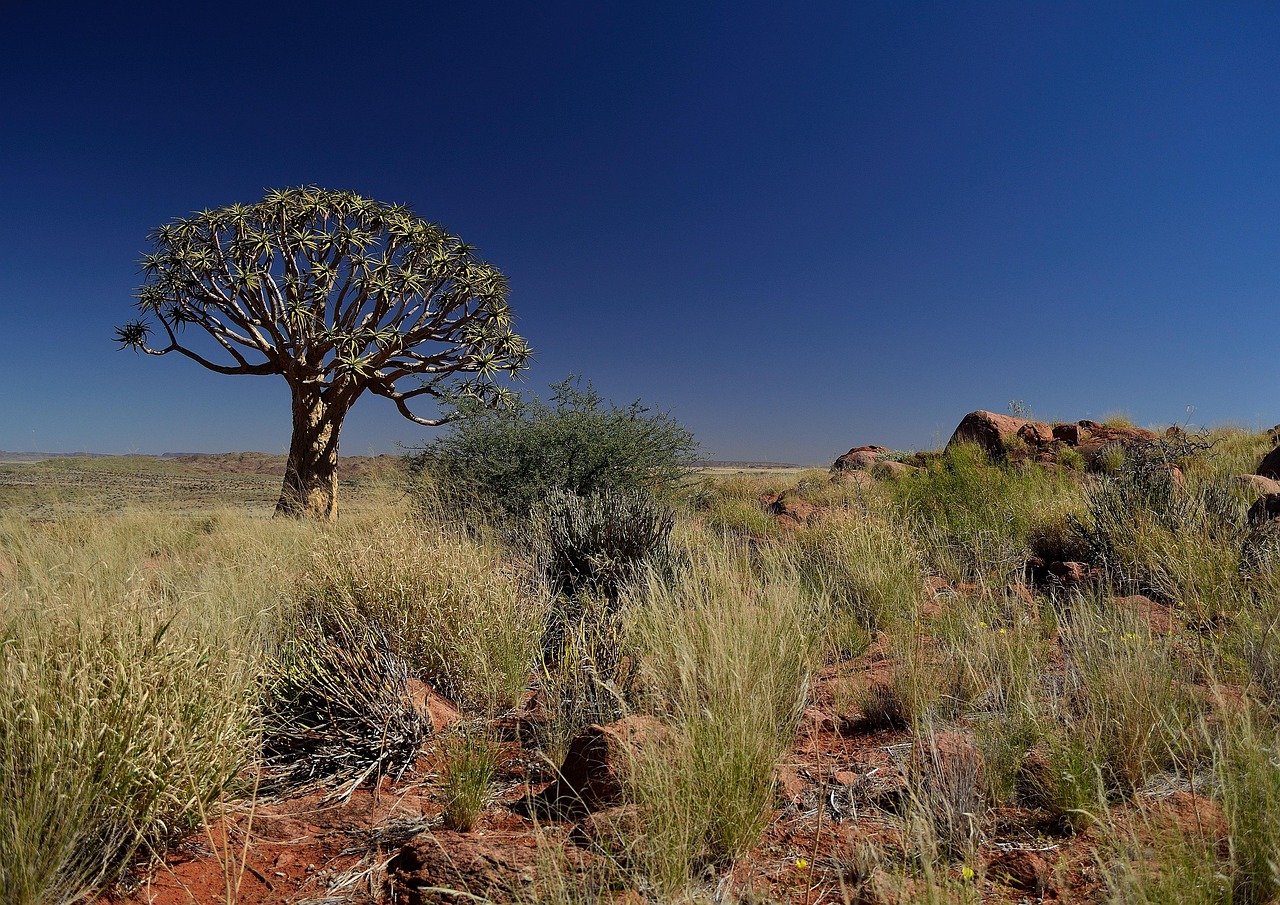The Quiver Tree, or Aloe dichotoma, has a growth rate that typically ranges from 12 to 24 inches per year under ideal conditions. This unique succulent tree is native to Southern Africa and thrives in arid environments, making it a fascinating addition to gardens and landscapes.
Understanding the Quiver Tree
The Quiver Tree, also known as the Aloe dichotoma, is a striking succulent that captures the attention of many gardeners and succulent enthusiasts. This tree-like plant is native to the deserts of Southern Africa, particularly Namibia and South Africa. It is known for its unique shape, resembling an umbrella due to its forked branches and dense rosettes of leaves.

Quiver Trees are not only visually appealing but also play an important role in their ecosystem. They provide shelter and food for various species, including birds and insects. The name “Quiver Tree” comes from the indigenous San people, who used the tree’s branches to make quivers for arrows due to their lightweight and sturdy nature.
Growth Conditions for Quiver Trees
To achieve optimal growth rates, Quiver Trees require specific environmental conditions. Here are some key factors that influence their growth:
- Soil Type: Well-draining sandy or rocky soil is essential. Heavy clay soils can cause root rot.
- Sunlight: Full sun exposure is ideal. Quiver Trees thrive in bright light and should receive at least six hours of direct sunlight daily.
- Watering: These succulents are drought-tolerant. Watering should be infrequent, allowing the soil to dry completely between waterings. Overwatering can be detrimental.
- Temperature: Quiver Trees prefer warm temperatures but can tolerate cooler conditions. They should be protected from frost.
Growth Rate Factors
While the average growth rate of a Quiver Tree is between 12 to 24 inches per year, several factors can influence this rate:

- Age: Younger Quiver Trees tend to grow faster than older specimens. Growth may slow down as they mature.
- Climate: Ideal climates with sufficient sunlight and minimal rainfall promote faster growth. Extreme conditions can hinder development.
- Nutrients: Providing adequate nutrients through occasional fertilization during the growing season can enhance growth rates.
Quiver Tree Lifespan
The lifespan of a Quiver Tree can exceed 50 years, with some individuals living for over 100 years. Their longevity is complemented by their slow but steady growth. Understanding their lifespan helps gardeners plan for long-term care and maintenance.
Propagation Techniques
For those interested in growing Quiver Trees, propagation can be done through seeds or offsets. Here are the methods explained:
| Propagation Method | Description |
|---|---|
| Seeds | Sow seeds in well-draining soil and keep them moist until germination occurs. This method takes time but can yield multiple plants. |
| Offsets | Offsets are small plants that grow around the base of the mature tree. Carefully remove and replant them in suitable conditions. |
The growth rate of Quiver Trees can vary significantly based on how they are propagated. Offsets may establish quicker than seeds due to their already developed roots.

Caring for Quiver Trees
Caring for a Quiver Tree involves monitoring its growth environment closely. Regular checks for pests and diseases are vital, as these plants can be susceptible to certain issues if conditions are not right.
Providing the right balance of sunlight, water, and nutrients will ensure a healthy, thriving Quiver Tree. Understanding its specific needs will help gardeners appreciate the beauty of this unique succulent while promoting its growth effectively.
Common Pests and Diseases
Quiver Trees, like many plants, can face challenges from pests and diseases. Being aware of potential issues is crucial for maintaining their health. Here are some common pests that may affect Quiver Trees:
- Aphids: These small insects suck the sap from the leaves, causing curling and yellowing.
- Mealybugs: They appear as white, cottony masses on the stems and leaves. Mealybugs can hinder growth by draining nutrients.
- Scale Insects: These pests can create a hard coating on the plant, affecting its overall vigor.
- Spider Mites: Tiny and often unnoticed, spider mites can create webbing and cause leaf damage.
Disease Prevention
Preventing diseases in Quiver Trees is essential for ensuring their longevity. Below are some strategies to keep your Quiver Tree healthy:

- Avoid Overwatering: Overwatering can lead to root rot, a common issue in succulents. Ensure that the soil dries out completely between waterings.
- Provide Good Air Circulation: Good airflow helps prevent fungal diseases. Avoid overcrowding plants in pots or gardens.
- Inspect Regularly: Check for signs of pests or disease early. Early detection can make treatment easier and more effective.
- Use Organic Insecticides: If pests are detected, consider using organic solutions to control them without harming the plant.
Seasonal Care for Quiver Trees
The care of Quiver Trees may vary with the seasons. Understanding the seasonal needs of these plants will enhance their growth and health.
Spring Care
Spring is the time for new growth. Here are key points to focus on during this season:
- Watering: Begin watering more frequently as temperatures rise but ensure the soil drains well.
- Fertilizing: Consider using a balanced fertilizer to support new growth.
- Pest Monitoring: Watch for early signs of pests as warmer weather can encourage their activity.
Summer Care
During summer, Quiver Trees experience their peak growth phase. Maintain proper care with these tips:
- Sun Exposure: Ensure they receive plenty of sunlight but provide some shade during extreme heat to prevent scorching.
- Watering Adjustments: Increase watering frequency based on temperature and humidity levels.
Autumn Care
As temperatures begin to drop in autumn, adjust care accordingly:
- Reduce Watering: Gradually decrease watering as the plants prepare for dormancy.
- Pest Inspection: Continue to monitor for any pests; they can be more prevalent during this transition.
Winter Care
Winter poses challenges for Quiver Trees, especially in colder climates. Here’s how to care for them during this season:
- Protect from Frost: If temperatures drop below freezing, consider bringing potted trees indoors or providing insulation for outdoor plants.
- No Fertilizing: Do not fertilize during winter as the plant is in a dormant phase.
- Minimal Watering: Water sparingly, allowing the soil to dry out completely before the next watering.
Environmental Considerations
Cultivating Quiver Trees requires an understanding of their natural habitat. These trees thrive in environments that mimic their native conditions. Here are some factors to consider:
- Drought Resistance: Quiver Trees are adapted to arid climates and can survive long periods without water.
- Sandy Soils: They prefer sandy or rocky soils that drain well, preventing over-saturation.
- Heat Tolerance: Quiver Trees can withstand high temperatures but should be protected from extreme heat stress.
Caring for a Quiver Tree involves understanding its unique needs and environmental preferences. By providing the right conditions and monitoring for any issues, gardeners can enjoy this unique succulent tree for many years.
Unique Characteristics of Quiver Trees
Quiver Trees possess several unique characteristics that make them stand out among succulents. These features not only enhance their visual appeal but also contribute to their adaptation in harsh environments. Here are some of the most notable traits:
- Branching Structure: Quiver Trees have a distinctive branching pattern that resembles an upside-down tree. Their branches fork out, creating a striking silhouette against the sky.
- Leaf Rosettes: The leaves grow in dense rosettes at the tips of the branches. They are thick and fleshy, designed to store water for dry periods.
- Flowering: In late summer to early autumn, Quiver Trees produce tall flower spikes covered in tubular yellow or orange flowers, attracting pollinators such as birds and insects.
Growth Stages of Quiver Trees
The growth of a Quiver Tree can be broken down into several distinct stages, each with its own requirements and characteristics. Understanding these stages can help gardeners provide better care throughout the plant’s life.
Seedling Stage
During the seedling stage, Quiver Trees are delicate and require careful attention. Here are some key points:
- Light Requirements: Young seedlings need bright, indirect sunlight to avoid scorching.
- Watering Needs: Water should be kept to a minimum. Allow the topsoil to dry out before watering again.
Juvenile Stage
As Quiver Trees progress into their juvenile stage, they begin to develop a more defined shape. This stage includes:
- Increased Water Requirements: Juvenile plants may need slightly more water, but care should still be taken to avoid overwatering.
- Transplanting: If grown in pots, this is often the stage to consider transplanting into a larger container to accommodate root growth.
Mature Stage
In the mature stage, Quiver Trees can exhibit impressive height and branching. Some important aspects include:
- Height and Spread: Mature Quiver Trees can reach heights of up to 30 feet and spread out significantly.
- Flowering Period: This is when the trees are most likely to produce flowers, contributing to their ecological role.
Cultivation Techniques for Quiver Trees
Successfully cultivating Quiver Trees requires knowledge of specific techniques that promote healthy growth. Below are some effective methods:
Container Growing
Growing Quiver Trees in containers is a popular option, especially in non-native areas. Consider the following:
- Container Size: Use a large pot with good drainage holes to accommodate root growth.
- Soil Mix: A cactus or succulent mix that provides excellent drainage is ideal.
Ground Planting
If planting directly in the ground, keep these tips in mind:
- Site Selection: Choose a location with full sun exposure and well-draining soil.
- Spacing: When planting multiple trees, ensure adequate spacing to allow for their wide spread.
Watering Practices
Implementing proper watering practices is crucial for Quiver Tree health:
- Water Less Frequently: During active growth, water more often, but ensure the soil dries out between waterings.
- Drought Management: Allow the plant to experience slight drought conditions, as this can encourage deeper root growth.
Nutrient Requirements
Nutrients play a vital role in the overall health of Quiver Trees. While they do not require excessive fertilization, here are some guidelines:
- Fertilizer Type: Use a diluted fertilizer designed for succulents during the growing season, typically in spring and summer.
- Nutrient Timing: Apply fertilizer every four to six weeks during active growth periods.
Pest Control Strategies
If pests do invade your Quiver Tree, there are several strategies for effective management:
- Isolation: If you notice any pests on one plant, isolate it immediately to prevent spreading.
- Natural Predators: Encourage beneficial insects such as ladybugs that naturally control pest populations.
- Diluted Soap Spray: Use a mixture of mild soap and water as a natural pesticide for soft-bodied insects like aphids and mealybugs.
Cultivating Quiver Trees successfully revolves around understanding their unique characteristics and providing the right conditions for growth. By implementing effective care strategies, gardeners can enjoy these remarkable plants for many years.
Propagation Challenges and Considerations
While propagating Quiver Trees can be rewarding, it is essential to be aware of the challenges that may arise during the process. Here are some common issues and considerations:
- Seed Germination Rate: The germination rate for Quiver Tree seeds can be low. Factors such as seed age and moisture levels play a significant role in successful germination.
- Environmental Stress: Young seedlings are sensitive to environmental stressors. Fluctuations in temperature or humidity can hinder their growth.
- Pest Infestation: Seedlings can be susceptible to pests. Regular monitoring is necessary to catch infestations early and take appropriate action.
Long-term Care for Quiver Trees
Once established, Quiver Trees will require ongoing care to ensure they thrive throughout their lifespan. Here are some long-term care tips:
- Routine Pruning: Prune dead or damaged branches to promote healthy growth and improve the tree’s overall appearance.
- Soil Maintenance: Regularly check the soil for drainage issues. Adding sand or perlite to the soil mix can improve drainage, especially in heavy soils.
- Mulching: Applying a layer of mulch around the base can help retain moisture while preventing weeds from encroaching.
Quiver Trees in Landscaping
Quiver Trees are not only fascinating as individual specimens but also add unique beauty to landscaping projects. Here are some ideas for incorporating them into your garden:
- Focal Point: Use a Quiver Tree as a focal point in a succulent garden, surrounded by lower-growing plants.
- Rock Gardens: Their unique shape and drought tolerance make them ideal for rock gardens where they can thrive with minimal water.
- Desert Landscapes: In xeriscaping designs, Quiver Trees complement other drought-resistant plants, creating an attractive and sustainable landscape.
Cultural Significance and Uses
The Quiver Tree holds cultural significance in Southern Africa, particularly among the San people. Historically, they have utilized this tree in various ways:
- Traditional Uses: The branches were traditionally used to make quivers for carrying arrows, hence the name “Quiver Tree.”
- Medicinal Properties: Some indigenous communities have used parts of the Quiver Tree in herbal remedies, although these practices vary.
Environmental Impact and Conservation
As unique as they are beautiful, Quiver Trees face threats from habitat loss due to climate change and human activities. Understanding the environmental impact is crucial for their conservation:
- Climate Change: Rising temperatures and changing rainfall patterns can affect their growth and distribution.
- Conservation Efforts: Organizations are working to protect natural habitats and promote awareness about the importance of preserving these iconic trees.
Final Thoughts
The Quiver Tree is a remarkable succulent that exemplifies resilience and beauty in arid environments. Understanding its growth rate, care requirements, and unique characteristics allows gardeners to appreciate and cultivate this extraordinary plant effectively. With proper attention to its needs—such as suitable soil, adequate sunlight, and careful watering—Quiver Trees can thrive for many years, contributing to both personal gardens and the broader ecosystem.
Whether you choose to grow them for their striking appearance or their ecological role, Quiver Trees are sure to be a conversation starter and a cherished addition to any landscape. As we continue to learn more about these unique trees, it becomes increasingly important to advocate for their conservation and sustainable cultivation practices. Embracing these principles will ensure that future generations can enjoy the beauty of Quiver Trees in their natural habitats and gardens alike.
